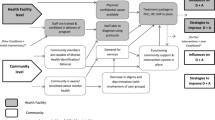Abstract
This research highlights the importance of expanding examinations of service accessibility for hard to engage client populations to include assessments of individuals’ ability to gain entrance to services and the system’s ability to meet the service needs of particular client populations. The results of this research provide a framework to support these examinations. The increasing levels of selectivity and targeting of mental health services to particular client populations found in this study raise fundamental questions about the goals of service accessibility in 21st century public mental health services generally, and for hard-to-engage clients particularly. These findings also point to the need for examinations of the eligibility criteria and gatekeeping mechanism that are used to target services to particular client populations to determine if they are working as intended and to assess what impact these mechanisms have on hard to engage clients’ ability to gain entrance to needed services.
Similar content being viewed by others
References
Pandini JA, Banks SM, Bramley J, et al. Measuring access to mental health care: a multi-indicator approach to program evaluation. Evaluation and Program Planning. 2002; 25:271–285.
Glied S, Frank R. Better but not best: Recent trends in the wellbeing of the mentally ill. Health Affairs. 2009; 28(3):637–648.
Osher, FC, Levine IS. Navigating the Mental Health Maze: A Guide for Court Practitioners. 2005. Council of State Governments.
Stiles PG, Boothroyd, RA, Snyder, K, et al. Service penetration by persons with serious mental illness: how should it be measured? The Journal of Behavioral Health Services & Research. 2002;29(2):198–207.
Abram KM, Teplin, L. Co-occurring disorders among mentally ill jail detainees: implications for public policy. American Psychologist. 1991;46:1036–1045.
Lovell D, Gagliardi G, Peterson P. Recidivism and use of services among persons with mental illness after release from prison. Psychiatric Services. 2002;53:1290–1296.
Padgett D, Struening EL, Andrews, H. Factors affecting the use of medical, mental health, alcohol, and drug treatment services by homeless adults. Medical Care. 1990;28:805–821.
Ridgely M, Goldman H, Willenbring M. Barriers to the care of persons with dual diagnoses: organizational and financing issues. Schizophrenia Bulletin. 1990;16(1):123–132.
Whitmer GE. From hospitals to jails: the fate of California's deinstitutionalized mentally ill. American Journal of Orthopsychiatry. 1980;50:65–75.
Draine J. Wilson AB. Pogorzelski W. Limitations and potential in current research on services for people with mental illness in the criminal justice system. Journal of Offender Rehabilitation. 2007;45:159–177.
Wilson AB, Draine J. Collaborations between criminal justice and mental health system’s in prisoner reentry. Psychiatric Services. 2006;57:875–878.
Smith, BD, Marsh JC. Client-service matching in substance abuse treatment for women with children. Journal of Substance Abuse Treatment. 2002;22(3):161–168.
Department of Behavioral Health and Intellectual disability Services. Offices of Mental Health. Available online at http://www.dbhids.org/office-of-mental-health-omh. Accessed on 3/22/12.
Padgett D. Qualitative Methods in Social Work Research: Challenges and Rewards. Thousand Oaks, CA: Sage, 2008
Morgan DL. Focus Groups as Qualitative Research. 2nd ed. Thousand Oaks, CA: Sage, 1997.
Emerson RM, Fretz RI, Shaw LL. Writing Ethnographic Field Notes. Chicago, IL: University of Chicago Press, 1995.
Strauss AL, Corbin J. Basics of Qualitative Research: Techniques and Procedures for Developing Grounded Theory. Thousand Oaks, CA: Sage, 1998.
Grob G. From Asylum to Community: Mental Health Policy in Modern America. Princeton, NJ: Princeton University Press, 1991.
Cutler DH, Bevilacqua J, McFarland BH. Four decades of community mental health: a symphony in four movements. Community Mental Health Journal. 2003;39:381–398.
Mowbray CT, Grazeir KL, Holter M. Managed behavioral health care in the public sector: will it become the third shame of the states? Psychiatric Services. 2002;53(2):157–171.
Mechanic D. From Advocacy to Allocation: The Evolving American Health Care System. New York, NY: The Free Press, 1986
Hogan MF. The president’s new freedom commission: recommendations to transform mental health care in America. Psychiatric Services. 2003;54:1467–1474.
Power AK. A public health model of mental health for the 21st century. Psychiatric Services. 2009;60:580–584.
Goldman HH, Glied SA, Alegria M. Conclusion: mental health in the mainstream of public policy. American Journal of Psychiatry. 2009;166:1215–1216.
Morrissey JP, Fagan JA, Coczza JJ. New models of collaboration between criminal justice and mental health systems. American Journal of Psychiatry. 2009;166:211–1214.
Acknowledgments
This research was funded in part by a grant from the Leonard Davis Institute of Health Economics, University of Pennsylvania.
Conflicts of interest
The authors report no competing financial interests or commercial relationships
Author information
Authors and Affiliations
Corresponding author
Rights and permissions
About this article
Cite this article
Wilson, A.B., Barrenger, S., Bohrman, C. et al. Balancing Accessibility and Selectivity in 21st Century Public Mental Health Services: Implications for Hard to Engage Clients. J Behav Health Serv Res 40, 191–206 (2013). https://doi.org/10.1007/s11414-012-9307-x
Published:
Issue Date:
DOI: https://doi.org/10.1007/s11414-012-9307-x



